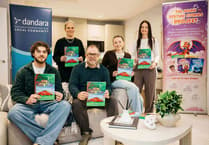Coroner of Inquests Jayne Hughes last week opened three of the five inquests stemming from this year’s TT races.
Mrs Hughes opened and adjourned the inquests into the deaths of David Morgan, Mark Purslow and Cesar Chanal. Inquests into the deaths of Roger and Bradley Stockton haven’t yet opened.
Mark Purslow, aged 29, from Llanon in Ceredigion, Wales, was killed in an incident during the fourth qualifying session which occurred at Ballagarey, Glen Vine on his third lap of the session on Wednesday, June 1.
The welder and fabricator had set his fastest ever lap of the TT Mountain Course at 120.86mph earlier in Wednesday’s session.
Mrs Hughes recorded that Dr Ervin Long’s post-mortem said the cause of death was head and neck injuries. In adjourning the inquest for a date yet to be determined, Mrs Hughes extended her condolences to Mr Purslow’s family and friends.
The second inquest opened by Mrs Hughes was of David Stanley Morgan, 52, from Saintfield, Northern Ireland. The lorry driver, who was a veteran road racer, crashed at the 27th Milestone at the start of the Mountain Mile section of the course during the final lap of the Supersport race on Monday, June 6.
That race was his 80th start at the TT from which he had achieved 49 finishes, including 25 top-20 results.
Dr Long’s post-mortem examination ruled that the cause of Mr Morgan’s death was from neck and chest injuries. Mrs Hughes extended her condolences to his friends and family in adjourning the inquest for a date yet to be determined.
The final inquest opened by Mrs Hughes was that of Cesar Chanal. Mr Chanal tragically died during an incident at Ago’s Leap in during the first lap of the sidecar race on Saturday, June 4.
Mr Chanal Louis Roger Chanal, aged 33, from Bron in France, died as a result of what Dr Long simply referred to as ‘multiple injuries’.
In the hours after the crash, which saw Mr Chanal’s passenger, Olivier Lavorel, critically injured, it was reported that the latter had died. This was later corrected four days after the crash.
Mrs Hughes described the inquest as occurring in ‘more difficult circumstances’ and noted that identification of Mr Chanal had been ‘by no way straightforward’.
The coroner gave more detail than usual for an inquest opening. These included witness statements which she said had been important in determining the identity of the dead rider.
The first statement she read was from Samuel Gash, a mechanic for Chanal and Lavorel. Mr Gash said that he had been working on the sidecar during the first practice session of this year’s TT when he heard them discussing their dog tags.
He said that the tags had no chains so the men decided to put them into the pockets on their leathers. Mr Gash added he had never heard them discuss tags before and he was ‘unaware’ of any routine they may have had.
In a second statement, Mr Gash, referencing the confusion around the identity of the dead male, said that Lavorel wouldn’t know how to drive the sidecar and said that ahead of their crash everything had been ‘as normal’. He added: ‘I can’t remember anything out of the ordinary.’
The next witness statement Mrs Hughes read from was that of Gary Thomas, a pathologist at Noble’s Hospital. Mr Thomas said he had been requested to attend the mortuary by the police on the day of the crash.
Mr Thomas said the deceased had ‘experienced extreme trauma to the whole body’ and was ‘unidentifiable’. He added that he checked for a dog tag, but was unsure he would find one due to the injuries suffered.
It was only when searching the rider’s leathers he discovered an ID tag which ‘identified the patient to be Olivier Lavorel’. This tag was then checked and confirmed by the attending police officer.
Mr Thomas said it was then that Dr Gareth Davies arrived at the mortuary wanting to check the ID of the deceased as he had found a tag in A&E on the surviving rider. The information on the tag found on the dead man was confirmed by Mr Thomas and the police officer.
However, on June 7, Mr Thomas said that during a break while performing the post-mortem, it became apparent that the ID of the men was being questioned. He tried to find additional information on the dead man, but there was no additional information available.
He added that everything that could be done was done to check on the identity of the man and he was ‘devastated’ that an apparent mistake was made which added to the trauma for family and friends of both men. He added that this was ‘not helped’ by what he described as ‘media speculation and false headlines’.
Mrs Hughes later read from statements from Dr Gareth Davies, a consultant at Noble’s and Dr Griffith Evans, the chief medical officer at race control. Dr Davies said he went to the scene and could not find dog tags on either rider and was unable to identify either man at the scene. Having been sent pictures of each rider, Dr Davies went to check on the identity of the man who was receiving treatment but was unable to do so due to the injuries he had sustained.
He also revealed that while the dead man’s helmet had been found, the helmet of the rider who was taken to Noble’s for treatment could not be found at this time.
When later searching the man’s leathers at Noble’s Hospital, he found a dog tag which identified him as Cesar Chanal.
Dr Evans said that he, like others, had been unable to determine ID at the scene, but he was later contacted by Dr Davies to say the men had been identified by their tags at Noble’s.
On Tuesday, June 7, clerk of the course Gary Thompson, contacted Dr Evans to tell him about the concerns over the identification of each man. He said that the concern was based on two main facts, firstly that an intact helmet had been found at the scene which could only match the injuries sustained by the surviving man.
Secondly, the team had reviewed video footage of the crash which indicated that the passenger had been thrown clear and the driver had impacted the wall.
After these concerns were raised with the coroner’s office, this was flagged with Walton Hospital, where the injured rider was receiving treatment. The matron there said that Cesar Chanal’s mother had travelled from France to see him.
Hospital staff spoke to her when she arrived and explained the situation before she visited the patient in Walton on two occasions and confirmed to the staff that the man they were treating was Olivier Lavorel.
When Lavorel’s brother arrived in the island, he too was informed of the situation and said the two men were easy to tell apart as Chanal had long hair and Lavorel short hair.
Walton then confirmed that the man they were treating had short hair. A further check of the men’s blood groups showed that Walton was definitely treating Lavorel.
In a second statement Dr Evans said he was asked by the police if he had ever heard of riders swapping dog tags and he said he never heard of this in his 20 years of involvement.
A further statement from a police officer, Detective Sergeant Harrison, revealed that while similar, one of the men’s helmets had distinct markings which had been clearly visible before the crash.
In adjourning the inquest, Mrs Hughes said she made no apology for the detail she entered ‘given the confusion that had been caused previously’ and noted that identification was ‘extremely difficult’ due to the nature of the injuries suffered.
Mrs Hughes said that while the original death announcement was made in the best of faith, it was ‘unfortunate’ that the information was released before ID was confirmed.
She added that while it has been confirmed that each rider was wearing each other’s tags, it is not yet possible to say why and asked the public not to speculate about this.
In adjourning the inquest, Mrs Hughes extended her condolences to Mr Chanal’s family and friends and her sympathies to Mr Lavorel’s friends and family for the distress they have experienced and wished him a speedy recovery.

.jpeg?width=209&height=140&crop=209:145,smart&quality=75)


